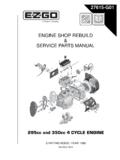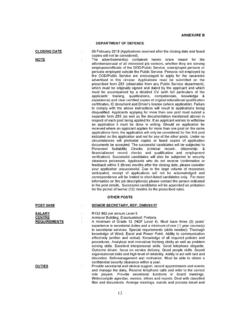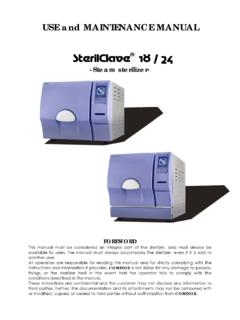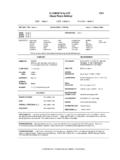Transcription of ELEMENTS by ICP 7303 (Hot Block/HCl/HNO3 …
1 NIOSH Manual of Analytical Methods (NMAM), Fourth EditionELEMENTS by ICP7303(Hot Block/HCl/HNO3 Digestion)MW: Table 1 CAS: Table 2 RTECS: Table 2 METHOD: 7303, Issue 1 EVALUATION: PARTIALI ssue 1: 15 March 2003 OSHA: Table 2 NIOSH: Table 2 ACGIH: Table 2 PROPERTIES: Table 1 ELEMENTS :aluminumcadmiumindiumnickelstro ntiumzincantimony*calciumironpalladiumte lluriumarsenicchromiumlead*phosphorustha lliumbariumcobaltmagnesiumplatinumtin*be rylliumcoppermanganesepotassiumtitaniumb ismuth*galliummolybdenumseleniumvanadium borongoldneodymiumsodiumyttrium* With certain restrictions (see Table 3)SAMPLINGMEASUREMENTSAMPLER:FILTER( :m, cellulose ester membrane)FLOW RATE:1 to 4 L/minVOL-MIN:Table 1 -MAX:Table 1 SHIPMENT:RoutineSAMPLESTABILITY:StableBL ANKS:2 to 10 field blanks per setTECHNIQUE:INDUCTIVELY COUPLED ARGONPLASMA, ATOMIC EMISSIONSPECTROSCOPYANALYTE:See element list aboveREAGENTS:Conc. HCl, mL; and conc.
2 HNO3, mLFINALSOLUTION:5% HCl and 5% HNO3, 25 mLWAVELENGTH:Element and instrument specificBACKGROUNDCORRECTION:Spectral wavelength shiftCALIBRATION: ELEMENTS in 5% HCl, 5% HNO3 RANGE:LOQ to 50,000 :g/sample [1]ESTIMATED LOD:Varies with element; Table 1 PRECISION ( ):Not evaluatedACCURACYRANGE STUDIED:5,000 to 50,000 :g/sample BIAS:Not determinedOVERALL PRECISION:Not determinedACCURACY:Not determinedAPPLICABILITY: The working range of this method is up to 100 mg/m3 for each element in a 500-L sample (the minimumrange depends on the LOD for each sample; see Table 1). The analysis is not compound specific. Certain elementalcompounds are known to be acceptable or unacceptable by this method (see Table 3). For unverified compounds, a test runshould be conducted using a known amount of the compound in question to determine : Interferences are spectral in nature and are accounted for by choosing appropriate wavelengths, applyinginterelement correction factors, and background METHODS: Alternative, more sensitive methods exist for some ELEMENTS by graphite furnace atomic absorptionspectroscopy.
3 This method is similar to NIOSH Method 7301, differing only in the use of the hot block for digestion of by ICP (Hot Block/HCl/HNO3 Ashing): METHOD 7303, Issue 1, dated 15 March 2003 - Page 2 of 6 NIOSH Manual of Analytical Methods (NMAM), Fourth EditionREAGENTS: acid,* conc., ultra pure. acid,* conc., ultra pure. stock solutions, 50-1000 : available single elementsolutions or multielement solutions preparedas instructed by the instrument manufacturer. , prepurified. , deionized, Type II water. solution: 5% HCl : 5% HNO3. Toabout 600 mL of deionized water in a 1-Lvolumetric flask, slowly add 50 mL conc. HCland 50 mL conc. HNO3. Dilute to the markwith deionized water.*See SPECIAL PRECAUTIONSEQUIPMENT: : cellulose ester membrane filter, :m pore size, 37-mm diameter; in cassettefilter sampling pump, 1 to 4 L/min, withflexible connecting coupled argon plasma-atomicemission spectrometer, equipped as specifiedby the manufacturer for analysis of elementsof block apparatus at 95 vessels and caps, , electronic and , two-stage, for PRECAUTIONS: Concentrated acids are powerful oxidizers, toxic, and corrosive liquids.
4 Wear protective clothing and work in a fume : each personal sampling pump with a representative sampler in line. at an accurately known flow rate between 1 and 4 L/min for a total sample size of 200 to 2000 Lfor TWA measurements. Do not exceed a filter loading of approximately 2 mg total PREPARATION: the cassette filter holder and with forceps remove the sample filter. Fold the filter into quarterstaking care not to lose any sample, and transfer to a clean, 50-mL hot block digestion tube. mL HCl. Cover with a plastic watchglass. Place in the hot block and heat at an internaltemperature of 95 /C for 15 :The internal temperature may vary from the digital readout. Calibrate the hot block prior todigestion. the sample from the hot block and cool for 5 minutes. Remove watchglass and add mLHNO3. Replace watchglass and return to hot block at 95 /C for 15 minutes.
5 The sample from the hot block and cool for at least 5 minutes. Rinse watchglass into the samplecontainer and discard watchglass. to 25-mL final volume with distilled, deionized Type II AND QUALITY CONTROL: the spectrometer according to the manufacturer's recommendations. Use standards consistingof the same 5% HCl : 5% HNO3 matrix as the samples. a standard every 10 a media blank every 20 samples, and a reagent blank every 10 a set of two laboratory control samples every 40 samples of a given matrix for a given recoveries with at least two spiked media blanks per ten :In the determination of lead, there may be a measurement interference (for example, sampleswith high aluminum levels). More recent instruments have a correction for this. ELEMENTS by ICP (Hot Block/HCl/HNO3 Ashing): METHOD 7303, Issue 1, dated 15 March 2003 - Page 3 of 6 NIOSH Manual of Analytical Methods (NMAM), Fourth spectrometer to conditions specified by standards, samples and quality control :If the elemental value for a sample is above the linear range of the element(s) in question, dilutethe sample solution with 5% HCl : 5% HNO3 diluting solution, reanalyze and apply the appropriatedilution factor in the the solution concentrations for the sample, Cs (:g/mL), and the average media blank, Cb (:g/mL),from the the solution volumes of sample, Vs (mL), and media blank, Vb (mL), calculate the concentration,C (mg/m3), of each element in the air volume sampled, V (L):NOTE: :g/L / mg/m3 EVALUATION OF METHOD.
6 The method was evaluated for all ELEMENTS and compounds listed in Table 1 and Table 2 between 1999 and2001 using known amounts of bulk material [4]. Evaluation is ongoing for additional ELEMENTS andcompounds. The limits of detection and quantitation were also determined for each element. Two ICPinstruments were used in the evaluation, a Thermal Jarrell Ash Model 61E [5] and a TJA IRIS [6], operatedaccording to the manufacturer's instructions. REFERENCES:[1]WOHL [2001]. Metals validation using hot block digestion, Unpublished data. Wisconsin OccupationalHealth Laboratory, Madison, WI.[2]NIOSH [1994]. Method 7300: ELEMENTS by ICP, NIOSH Manual of Analytical Methods, Fourth Edition,Issue 2, Aug. 15, 1994.[3]WOHL [2001]. Metals Manual 2001, WOHL Internal Document, Updated Apr. 1, 2001. WisconsinOccupational Health Laboratory, Madison, WI.[4]WOHL [2001].
7 WOHL General Operations Procedures Manual, WOHL Internal Document, Updated2001. Wisconsin Occupational Health Laboratory, Madison, WI.[5]Thermal Jarrell Ash [1991]. ICAP 61E Plasma Spectrometer Operator's Manual, Thermal Jarrell AshCorp., Part No. 128832-01, Feb., 1991.[6]Thermal Jarrell Ash [1997]. IRIS Plasma Spectrometer User's Guide, Thermal Jarrell Ash Corp., Part , Feb. 4, WRITTEN BY: Jason Loughrin, Lyle Reichmann, Doug Smieja, Shakker Amer, Curtis Hedman Wisconsin Occupational Health Laboratory (WOHL). ELEMENTS by ICP (Hot Block/HCl/HNO3 Ashing): METHOD 7303, Issue 1, dated 15 March 2003 - Page 4 of 6 NIOSH Manual of Analytical Methods (NMAM), Fourth EditionTABLE 1: ANALYTE INFORMATION FOR VALID ELEMENTS AND COMPOUNDSA nalytePropertiesMW MP ( C)LOD(:g/mL)LOQ(:g/mL)EstimatedLOQ(:g/sa mple)*Minimum** air vol. (L)Maximum**air vol. (L)Al 210,000As 85,000, 13,300B 13, 1100,000Be 3525,000, 110,000Ca 210,000 CaO 310, 3500,000Co 3500,000Cr 8500,000Cu 15500,000Fe 15,000Fe2O3(as Fe)
8 15,000Ga 13, 15500,000Mg 110,000 MgO 533,000Mn ,000Mo ,000Nd ,300Ni 150,000P 25 250500, 35100, , 20025,000, 3100,000Se 8250, 125,000Sr 300100,000, 125500,000Ti , 35500,000V ,000Y ,000Zn ,000 ZnO ,000*Value based on a 25-mL sample volume.**The minimum sampling volume needed to obtain the OSHA PEL at the LOQ for the element/compoundat a sample digestion volume of 25 mL.**The maximum sampling volume for a given sample, calculated by taking 50,000 :g as the limit for theelement/compound per :The LOD and LOQ values are dependent on the particular analytical instrument used.
9 Also,LOD and LOQ values may vary for a particular element due to certain by ICP (Hot Block/HCl/HNO3 Ashing): METHOD 7303, Issue 1, dated 15 March 2003 - Page 5 of 6 NIOSH Manual of Analytical Methods (NMAM), Fourth EditionTABLE 2. EXPOSURE LIMITS, CAS #, RTECSE lement(Symbol)CAS #RTECS Exposure Limits, mg/m3 (Ca = carcinogen) OSHA NIOSH ACGIHS ilver (Ag) (dust, fume, metal) (metal, soluble) (metal) (soluble)Aluminum (Al)7429-90-5BD033000015 (total dust) 5 (respirable)10 (total dust)5 (respirable fume)2 (salts, alkyls)10 (dust)5 (powders, fume)2 (salts, alkyls)Arsenic (As)7440-38-2CG0525000variesC , , CaBarium (Ba) (Be) , C , , CaCalcium (Ca)7440-70-2--variesvariesvariesCadmium (Cd) feasible, (total), (respir.), CaCobalt (Co) (dust, fume) (dust, fume)Chromium (Cr) (Cu)7440-50-8GL53250001 (dust, mists) (fume)1 (dust) (fume)1 (dust, mists) (fume)Iron (Fe)7439-89-6NO456550010 (dust, fume)5 (dust, fume)5 (fume)Potassium (K)7440-09-7TS6460000------Lanthanum7439 -91-0-- --Lithium (Li)7439-93-2--------Magnesium (Mg)7439-95-4OM210000015 (dust) as oxide5 (respirable)10 (fume) as oxide10 (fume) as oxideManganese (Mn)7439-96-5OO9275000C 51; STEL 35 (dust)1.
10 STEL 3 (fume)Molybdenum (Mo)7439-98-7QA4680000 5 (soluble)15 (total insoluble) 5 (soluble)10 (insoluble) 5 (soluble)10 (insoluble)Nickel (Ni) , (soluble)1 (insoluble, metal)Phosphorus (P) (Pb) (Sb) (Se) (Sn)7440-31-5XP7320000222 Strontium (Sr)7440-24-6 --Tellurium (Te) (Ti)7440-32-6XR1700000------Thallium (Tl) (skin) (soluble) (skin) (soluble) (skin)Vanadium (V)7440-62-2YW240000--C 5510 (STEL)510 (STEL)Yttrium (Y)7440-65-5ZG29800001N/A1 Zinc (Zn)7440-66-6ZG8600000 ----Zirconium (Zr)7440-67-7ZH707000055, STEL 105, STEL 10 ELEMENTS by ICP (Hot Block/HCl/HNO3 Ashing): METHOD 7303, Issue 1, dated 15 March 2003 - Page 6 of 6 NIOSH Manual of Analytical Methods (NMAM), Fourth EditionTABLE 3: VALIDATION SUMMARYA nalyteStatus1 AnalyteStatusAnalyteStatusAgNot ValidCuOValidSNot ValidAlValidFeValidSbPartially Valid4Al2O3 Not ValidFe2O3 ValidSb2O3 Partially Valid5 AsValidGaValidSeValidAuValidInValidSiNot ValidBValidKCIP endingSnPartially Valid6 BaPendingMgValidSnOPendingBaOPendingMgOV alidSnO2 PendingBaO2 PendingMnValidSrValidBaCl2 ValidMnOValidSrCrO4 Valid (by Cr)BaSO4 PendingMoValidTeValidBeValidNaClPendingT iValidBiPartially Valid2 NdValidTlValidCaValidNiValidVValidCaCO3 ValidPValidV2O5 ValidCaOValidPbPartially Valid3 YValidCdValidPbCrO4 Valid (by Cr)ZnValidCoValidPbOValidZnOValidCrValid PdValidZrNot ValidCuValidPtValidZrONot Valid 1 Status definitionsValid:The method is suitable for samples up to at least g bulk material with recoveriesof between 90 and 110 percent.














